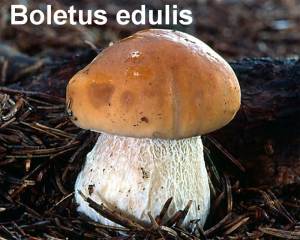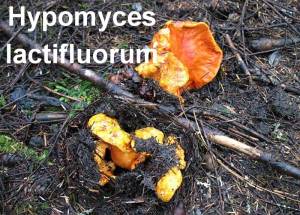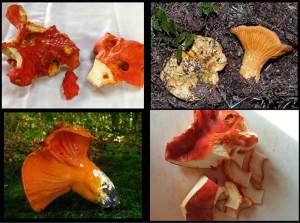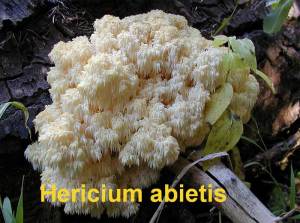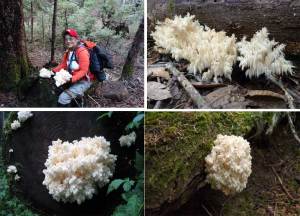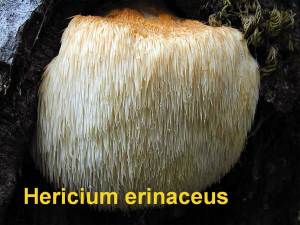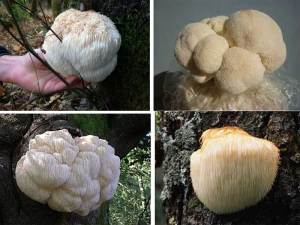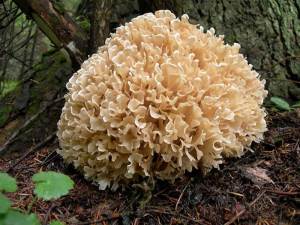New Mushroom: Cortinarius kroegeri
Paul Kroeger, a well known Canadian mycologist, who was one of our speakers in 2013 from Vancouver, BC, has a new species of the genus Cortinarius named in his honor.
This mushroom, Cortinarius kroegeri, is only known from the western North America, but further study will be necessary to determine this for certain.
Applause, applause, Paul, well done!
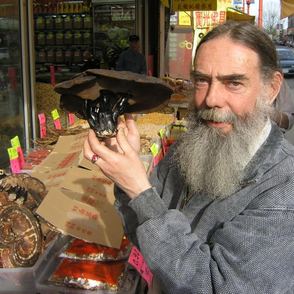 More info and pictures:
More info and pictures:
Subject: New species of Cortinarius named in Paul Kroeger’s honour
Few days ago, a new species of the genus Cortinarius was named in Paul Kroeger’s honour:
Cortinarius kroegeri Niskanen, Liimat., Harrower, Berbee, Garnica & Ammirati
CONGRATULATIONS, PAUL!
Paul gave me two sets of photos of the two paratypes and I posted them on Mushroom Observer:
http://mushroomobserver.org/230598 (photo below)
http://mushroomobserver.org/230586 (photo below)
For the description proper, see
http://www.indexfungorum.org/Publications/Index%20Fungorum%20no.294.pdf
Adolf & Oluna Ceska, Victoria, BC
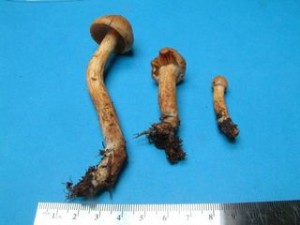
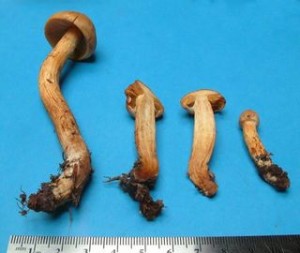
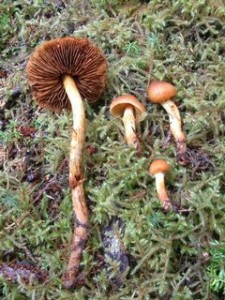
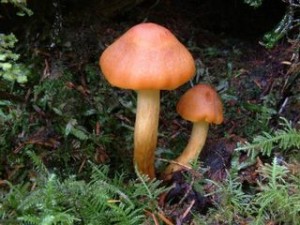
Truffle Association of BC fund raising events – February 6 and 7
The Truffle Association of BC has organized 3 truffle-inspired events to raise funds to support the maintenance of their demonstration Perigord black truffle orchard at UBC Farm in Vancouver.
All events are being held on the mainland.
Two events are described in the attached poster (look at one of the links below this message). Ticket purchase information is in the poster.(https://www.eventbrite.ca/e/truffle-festival-of-bctickets-20135279162)
1) Trouble with Truffles – $30 – presentations on truffles by 4 truffle enthusiasts, truffle dog demonstration, visit to UBC Farm truffle orchard, Vancouver, Saturday February 6 3-5pm
2) Truffle Hunt & Lunch – $80 – truffle dog search of truffle orchard followed by lunch, tour and tasting at Bacchus Bistro, Chaberton Estate Winery, Langley, Sunday February 7 11am-5pm
The third event is described below. Ticket purchase information is at the web site below.
3) The Truffle Feast, at a venue in Vancouver called the supper club that seats 36. Guests pay a $20 deposit (plus service fee) in advance and remaining ($79) and tip in cash upon arrival. From Chef Robin of Swallow Tail Culinary adventures: “If you love the flavour of umami (savoury), fresh truffles are some of the most intoxicating and exotic mushrooms around. Chef Jacob Deacon-Evans (Wildebeest, West, Bishops) creates a lavish truffle dinner at the secret supper club while truffle hunter Brooke Fochuk and truffle expert Shannon Berch talk about the truffles that grow in BC. Learn how Brooke and her dog Dexter find these expensive underground gems in the forest. It’s like food treasure!” Dining is long table style at a secret location in Vancouver (details emailed after booking), bring some red or white Burgundy to pair, Saturday Feb 6th, 6:30pm, $99
Book Now http://www.brownpapertickets.com/event/2494167
Attention Foray Participants
Just a friendly reminder that members attending forays are required to complete a liability waiver at the meeting area.
On the waiver, please list your cell# and vehicle# separately, one over the other. We need them both. Thank you!
Wild Mushroom Celebration Long Beach Peninsula, Washington October 1 – November 15, Annually
For more information, visit http://wildmushroomcelebration.com/events/
Tricholoma magnivelare
‘Tis the season for Matsutakes, and here is an excellent article by Langdon Cook.
https://story.californiasunday.com/mushroom-hunters-oregon-tokyo
Beryl Elizabeth Neff
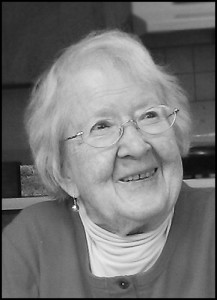
January 30, 1917-September 23, 2015 BERYL ELIZABETH NEFF, 98 a former 63-year resident of Lake Stevens, Wash. died peacefully on the first day of Autumn, September 23, 2015, at Kirkland’s Evergreen Hospital hours after suffering a heart attack. A memorial celebrating the life of a beloved mother, peace activist, certified Snohomish County Master Gardener and emeritus member of the Snohomish County Mushroom Society will be held 2:00 p.m., Saturday, October 10, 2015, with a potluck repast to follow, at Evergreen Unitarian Universalist Fellowship located at 1607 4th St., Marysville, Wash. Ironically, Beryl Neff died one month shy of the Oct. 24, 2001 passing of her husband and soul mate of 61 years, Harold Neff. Beryl Neff was born Jan. 30, 1917 in Sparks, Nevada to Betty and Frank Marlar, one of three children. In later years Beryl would say she was a quiet but inquisitive child, a voracious reader. The love of books, magazines and newspapers, including the Everett Herald, carried over to her last days when, she groused, her deteriorating eyesight made reading almost next to impossible. After her parent’s divorce, Beryl joined her mother in San Francisco, California where she resided until 1948. In the early 1940s, she received a degree as a registered nurse. Besides working in hospitals in San Francisco and Everett, Beryl was the “go to” nurse in an extended family that grew by 12+ via marriage in 1940. Beryl’s oldest son, Andy, recalls that nearly every Neff and Marlar family member stricken with a serious illness, Beryl Neff was an attending nurse. It was in 1939 Beryl Marlar, 24, was introduced by Emma Neff Hopkins to her brother, Harold, 25. In 1940 they became Mr. and Mrs. Harold Neff. It was a union resulting in four children, and eventually, seven grandchildren, twelve great-grandchildren, and four great-great grandchildren. It was in 1948, the H.A. Neff’s, now comprised of two kids, Andy and Kristin, moved from San Francisco to Washington State and rural Snohomish County’s Lake Stevens. Harold, born in Granite Falls, returned home having secured employment as a Machinist. It was also in 1948 that the Neff family moved into a home on 3/4 of an acre, at 2024 Cedar Road, at the north end of Lake Stevens. Stately Neff Manor, as it was known, was given many remodeling jobs in the course of the next 61 years, including the indoor swim-ming pool Harold built beginning in the late 1960s and opened for business in 1970. But one constant was the thriving vegetable garden. Home-grown organic vegetables, canned fruit from the apple and pear trees and grape vineyard were a constant for a family that grew to four by 1954 with the arrival of son, David and daughter, Barbara. Beryl Neff, in time, became a certified Snohomish County Master Gardener with her garden proof of her gardening prowess. Another one of Beryl and Harold’s passions was hunting for mushrooms. It almost proved a fatal attraction one afternoon in the late 1980s. Harold, then not relegated to a wheel chair, from diagnosed muscular dystrophy, waited as he usually did for his wife and a friend on the outskirts of a wooded area off the Mountain Loop Highway, as the women searched for delectable mushrooms. When day turned into night and the women did not reappear, Harold drove back to Granite Falls to notify authorities. What followed was a media feeding frenzy with Seattle TV stations camped out on that logging road, capturing the worried face of a pacing Harold Neff. After a night out in the Mountain Loop Highway wilderness, Beryl and her friend were led out of the outback by authorities, no worse for wear, but hungry. Beryl continued as a member of the Snohomish County Mushroom Society, attending into her late 80s, the annual Fall show at Legion Park in Everett. It was in the early 1960s, after the 1962 Cuban Missile Crisis that saw the world teetering on nuclear Armageddon, that Beryl Neff became a committed Snohomish County peace activist. As the years progressed, and the Vietnam War morphed into the endless War on Terror with US wars in Afghanistan and Iraq, Beryl kept protesting, smiling with pride, when a grandchild called her an authentic “raging grandma.” She was among the last protestors at the now defunct anti-war vigils outside the Everett Post Office on Hewitt Avenue. Beryl’s training as a registered nurse was put to the test when she became the principal caregiver for Harold in 1991 after the latter’s lengthy recovery from open-heart surgery caused his muscles to atrophy from muscular dystrophy. Harold, thanks to Beryl’s care, lived another 10 years, passing at age 85. Beryl remained a resident of Stately Neff Manor, living alone or with family members until 2011 when recovery from a stroke dictated a change of residence. For four years she was a resident of then Merrill Gardens at Mill Creek that morphed into Brookdale, an assisted living facility, save for a successful recovery in a skilled nursing facility from a broken hip. Beryl was popular among residents and staff, holding court in the cafeteria with friends at the evening meal. With the exception of daily changing of elastic socks to prevent her feet from swelling, Beryl was fiercely independent, not requiring any other assistance from staff as she went about her days reading newspapers, magazines and books until her eyesight deteriorated. She could be seen, as late as her last day on earth, strolling the corridors outside her apartment with her walker, always with a smile. Beryl Neff outlived her husband, his 12 siblings, her brother and sister, Vivian and Bill Marlar, and her daughter Kristin. Beryl is survived by her three children, Andrew, David and Barbara. She had seven grandchildren, 12 great grandchildren and six great-great grandchildren. In lieu of flowers, the family suggests donations be made to one of Beryl Neff’s favorite charities: Northwest Lifeline — Supplier of food banks throughout the Puget Sound.
0F9BD215-B31E-46A7-ACE2-5FB8CEC31238
SCMS show setup help needed!
We need your help on Saturday October 10 for our annual show preparation! Please contact: diannmize@hotmail.com if you’re interested in lending a helping hand.
Show Date: October 11 SCMS from 10am-5pm at Forest Park, Everett
Last year’s fires should bring a springtime of tasty mushrooms
Interesting article in the Seattle Times about mushroom hunting this year
WILD EDIBLE MUSHROOMS
Foraging for mushrooms has become quite popular. Is it due to a “back to nature” movement and consuming food that is natural, or is it the THRILL of finding something edible in the wild?
Whatever it is, be cautious about eating a mushroom without total identification that it is an edible. In fact, “a mushroom chooses its victim”. One can be allergic to them like being allergic to strawberries or seafood.
In the PNW, most edible mushrooms are found under conifer trees: Douglas fir, hemlock, pine, or spruce. They are said to be mycorrhizal, a mutually beneficial relationship between the trees’ roots and the fungi.
Interested in foraging for edible mushrooms? One way is to join a mushroom group. In the Seattle area, Puget Sound Mycological Society, the largest in the Pacific Northwest, and Snohomish County Mycological Society, north of Seattle are the closest. Both lead mushroom forays, or a field trip educating the public on edible, non-edible, or poisonous mushrooms. Another way would be to follow a seasoned forager who may or may not have been a former member of a mushroom group, and hunts independently.
In these groups, one of the most important lesson that one will come away with is how to identify key features of a mushroom. Learning to identify different parts of a mushrooms is crucial because these characteristics determine whether it is indeed the right mushroom for the table.
The unique key features mentioned here are for a typical gilled mushroom that most mushroomers hunt for. Exceptional nongilled mushrooms have only some of these characteristics.
KEY FEATURES OF A MUSHROOM
The following key features are what to look for in identifying the genus and species of a mushroom.
– The size, shape, and color of the cap and stalk.
– Underneath the caps, are there gills, sponge layer(pores), or teeth?
– Its odor.
– Its spore color.
– Other features like:
– a veil or ring around the stalk,
– a base with a volva
Be aware that photographs from a mushroom text book may be unreliable.
Selected here are five CHOICE edibles which can be easily distinguished from gilled mushrooms. Each key features are unique and have no poisonous look-a-likes.
BOLETUS edulis are better known as porcinis by the Italians, and cep by the French. Foraged during the summer and fall, these prized and delicious edibles can look like a bread bun protruding through duff, the decayed organic matter on the forest floor under conifers. Features that announce this delectable mushroom are its bald cap of any of these colors: brown, yellow-brown, or red- brown, and underside it are pores, a sponge like layer, that when young it is whitish, and turns olive green as it matures; it does not turn blue when handled. Just below the stem, a net like design decorates it.
A most desirable mushroom when sliced and dried, it makes a tasty and flavorful soup
HYPOMYCES lactifluorum aka Lobster mushroom is a pretty thing. In reality the mushroom originally was a Russula brevipes, a commonly white russula found in the Pacific Northwest. Engulfed by a parasite in rich conifer humus, and the host mushroom may hold its shape or another odd shape, but it is the fresh steamed red or red orange lobster color that magnetizes a forager’s eyes. Best sauteed in butter or pickled.
HERICIUM abietes, a striking white ball growing on a dead log from afar while hiking in the woods, would be overlooked by everyone except a mushroom forager. This beauty whose other name is Bear’s head, also a “teeth fungi”; once handled, will never be forgotten. Adorned with pretty white like icicles on its branches, this mushroom is delicious when sauteed in olive oil, or add it in eggs, or to a vegetable stir fry, semi crisped.
A novice forager, may mistaken a HERICIUM erinaceus for a Hericium abietes. Don’t be fooled. The difference is how the “teeth” are set. Aka “Lion’s Mane”, depending on age, is a medium or large white clump-like ball of spines hanging all over it. Find these on both living trees and dead logs in a forest. If foraging is out of the question, it can be cultivated or purchased from mushroom growers. Culinary delight depends on the consumer. One believes it tastes like seafood, another says it tastes bland.
SPARASSIS crispa, looks more like a cluster of egg noodles rather than a cauliflower, but Cauliflower mushroom is its accepted common name. Growing on stumps or Douglas fir tree roots and other conifers, it can easily be identified; look closely to find firm flat curly edges. Young white or slightly tan specimens weighing less than 5 pounds are better sought out, though difficult to clean with fir needles caught between its branches. Cook
thoroughly to tender it. Delicious in casseroles or in a frittata.
HYDNUM repandum called Hedgehog, a teeth fungi, competes with the Cantharellus cibarius, or popular yellow chanterelle as an edible. Some foragers prefer it because it is tastier. Hedgehogs’ caps and stalks range in color: white, pale orange, orange brown.
But its best unmistakeable feature are delicate white or pale orange spines called “teeth” hanging under its cap. Usually in large numbers on the ground under fir, hemlock, and pine. Prepare as you would a chanterelle, a little bit of butter, salt, and pepper
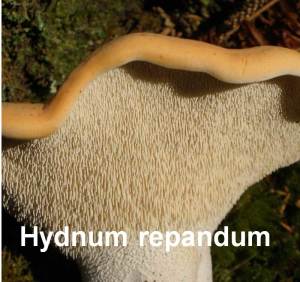
Before consuming any edible mushroom, be sure to follow these FIVE RULES:
1. Always be 100% sure of its identification
2. Always cook mushrooms thoroughly
3. Eat no more than one tablespoon when trying out a new mushroom; save a fresh sample in the refrigerator.
4. Eat only one mushroom at a time – wait 24 hours for any reaction.
5. Only eat mushrooms in good condition.
Finally, when unsure about any of a mushrooms’ key features, a CARDINAL RULE exists and that is:
WHEN IN DOUBT….THROW IT OUT!


